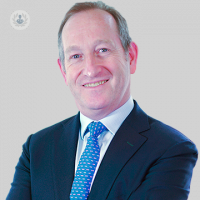Which patients is TAVI suitable for?
Written by:TAVI stands for transcatheter aortic valve implantation, a minimally invasive catheter-based procedure for patients with aortic stenosis. Aortic stenosis is a heart defect characterised by the narrowing of the aortic valve opening, which restricts blood flow from the left chamber of the heart to the aorta. Those with aortic stenosis may experience chest pain (angina), dizziness, palpitations, breathlessness and loss of consciousness.
Renowned cardiologist Dr Michael Mullen tells us all about TAVI, the possible risks faced with the operation, and the road to recovery.

What does the TAVI procedure involve?
TAVI is performed by introducing a valve into one of the blood vessels of the heart, usually done through the top of the leg. The valve is advanced with a guide wire into the heart and expands the narrowed valve, replacing the function of the valve, either using balloon techniques or a self-expanding mechanism.
Before the operation
Before a TAVI procedure, a number of investigations will be carried out. These will include an ECG to assess the rhythm of the heart and an echocardiogram which is an ultrasound of the heart to assess the valve function as well as the pumping function of the heart. A CT scan is also required to get a clear visual of the size of the heart valve to determine which type and what size of implant will work best. The CT scan will also determine the best place to introduce the valve, be it at the leg or at an alternative location. It will also allow the doctor to look at the coronary arteries. If the scan detects significant coronary disease, you may require a coronary angiography.
You will be admitted the day before the procedure and told whether or not you need to stop taking any medications prior to coming into the hospital.
During the procedure
The TAVI procedure is performed in the cardiac catheter lab; which is an X-ray lab that allows the surgeons to see the valve as it is introduced into the body. The TAVI procedure generally lasts between an hour to an hour and a half and is performed under local anaesthetic with the patient awake or with a small amount of sedation if the patient feels anxious.
Tubes are introduced into the blood vessels at the top of the leg. The valve is introduced through these tubes and implanted into the heart. The patient shouldn't feel anything as it passes through their body. Although some patients do have a little bit of discomfort, this is generally short-lived.
After the procedure, the patient will return to the ward and should be able to move within about four to six hours. Patients normally go home the next day, but sometimes it takes a little bit longer.
Is TAVI suitable for everyone?
TAVI is suitable for patients with aortic stenosis who are either at a high or intermediate risk for open heart surgery. Your doctor will discuss what the best and most appropriate option is for you with the help and guidance of a multidisciplinary team.
What are the risks with TAVI?
As with any heart operation, TAVI does have some risks, which can include serious complications. Death or stroke can occur in approximately two to three per cent of patients. In addition, there is a risk of injury to the blood vessel where the valve is introduced at the top of the leg. This can result either in bruising which may be excessive, or extensive bleeding which may require further intervention or surgery to repair the blood vessel at the top of your leg.
In about five to ten per cent of patients, a permanent pacemaker may need to be implanted, as the wiring of the heart which is very close to the aortic valve can get damaged during the TAVI procedure. Pacemaker implantation is a relatively straightforward local-anaesthetic procedure that can generally be performed on the same day or the next day after the TAVI procedure.
TAVI valves have known durability that may last between five and 15 years. That means, your valve may need to be replaced at some point in the future. Currently, we don't know for sure how long these valves will last, but the vast majority of patients do not require any further intervention. A small number of patients will have a leak around the valve which is called a paravalvular leak. On occasions, this may require additional intervention either with further stretching of the valve or even implantation of another valve.
How long does it take to recover from TAVI?
The main benefit of TAVI is that the recovery time is much shorter than that of open-heart surgery. Generally, it’s expected for the patient to be up and about after the procedure within four to six hours, with the potential to be discharged the next day.
The patient may feel a bit sore after the procedure but can expect to return to normal activities within a very short period of time, with improved exercise tolerance almost immediately. The doctor will follow up with them in about four to six weeks with repeat ECG and echocardiogram tests to assess the TAVI valve function. Meanwhile, if patients experience any symptoms, these should be evaluated right away.
For further information or to make a consultation with Dr Michael Mullen, you can book an appointment via Top Doctors.


